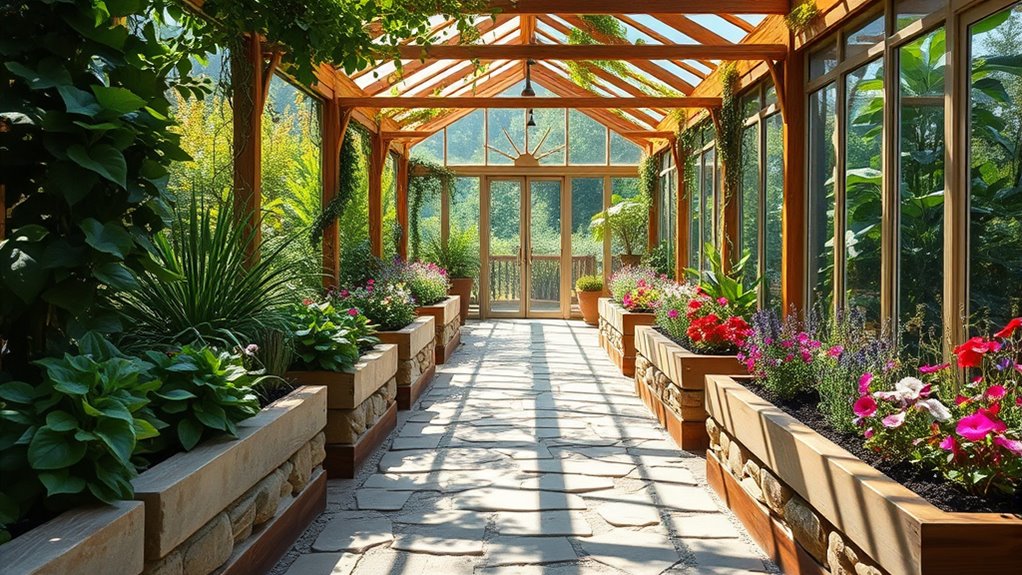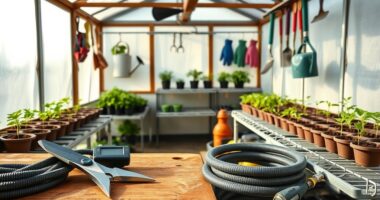To build a greenhouse pathway, choose materials like gravel for drainage or paving slabs for durability. Consider a width of 4 to 5 feet for easy access, and align pathways with airflow in mind. Effective drainage is essential to prevent water logging, while regular maintenance keeps your pathway in top shape. Safety features like non-slip surfaces and clear signage enhance accessibility. There’s plenty more to explore on optimizing your greenhouse pathway design and functionality.
Key Takeaways
- Choose materials like gravel or paving slabs for durability, drainage, and aesthetic appeal while avoiding slippery surfaces like sand.
- Design pathways 3 to 6 feet wide, ensuring at least 48 inches for accessibility and ease of navigation.
- Implement effective drainage solutions, such as French drains, to prevent water accumulation and maintain a healthy environment.
- Regularly inspect and maintain pathways for cleanliness, weed control, and structural integrity to ensure long-lasting functionality.
- Incorporate safety features, ensuring pathways are obstacle-free, non-slip, and accessible for users with mobility challenges.
Selecting the Right Materials for Your Pathway
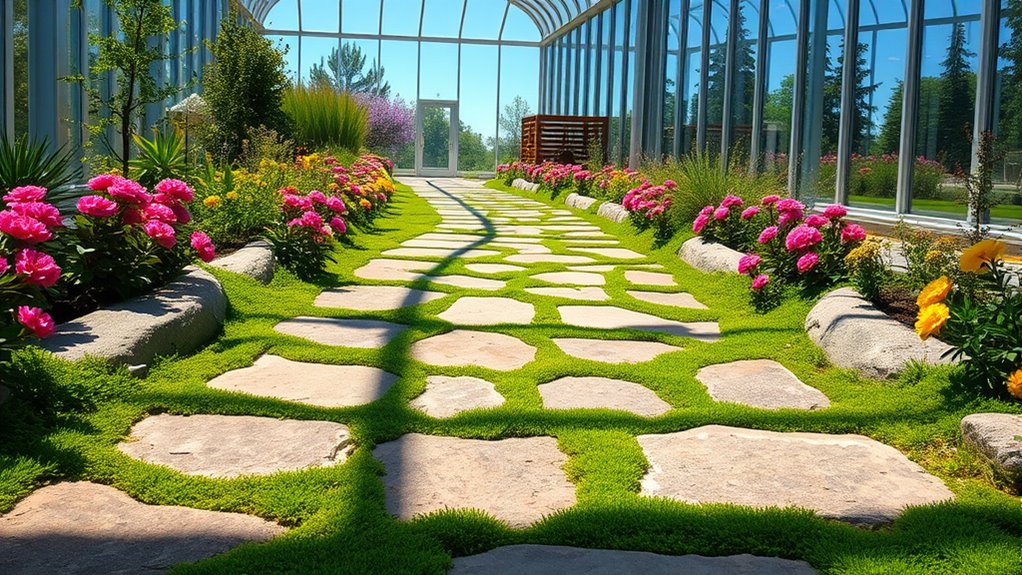
When selecting the right materials for your pathway, consider the five main options: gravel, paving slabs, natural stone, brick, and mulch.
Gravel and crushed stone are budget-friendly choices that provide excellent drainage and weed control. If you’re aiming for durability and aesthetics, paving slabs offer a more polished look but come with a higher cost.
Gravel and crushed stone offer affordable drainage and weed control, while paving slabs provide a stylish, durable option for a higher investment.
Natural stone can create stunning and intricate designs, although it may strain your budget. Brick paths, especially from leftover materials, can add charm without breaking the bank.
Finally, mulch is eco-friendly and inexpensive but needs regular replenishment. Each material brings unique benefits, so think about your budget, desired appearance, and maintenance preferences to choose the best option for your greenhouse pathway. Additionally, consider how your chosen material will complement your backyard greenhouse design, as this can enhance the overall appeal of your gardening space.
Key Design Considerations for Greenhouse Pathways
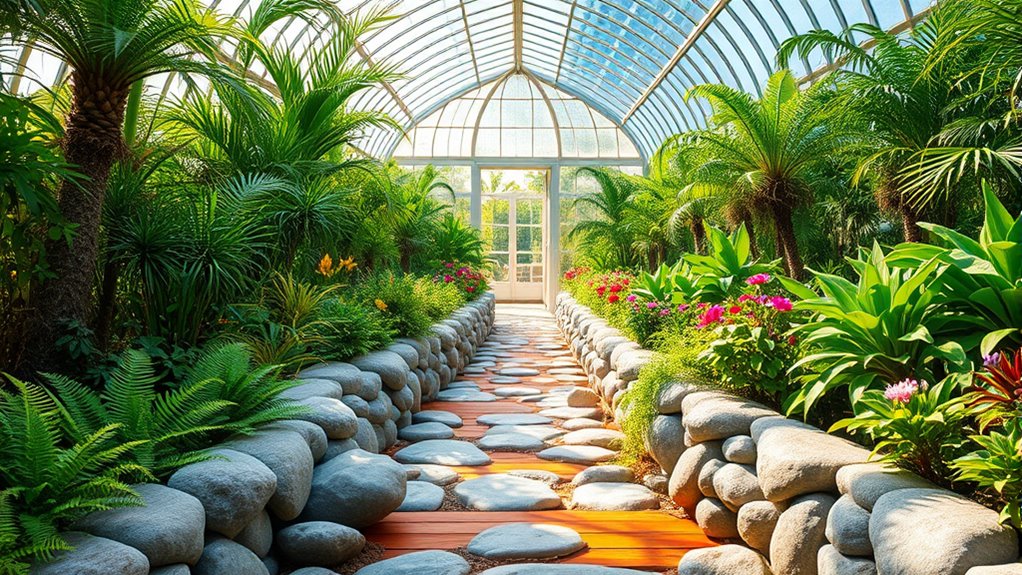
When planning your greenhouse pathways, consider how to optimize space utilization while ensuring effective drainage solutions.
Choosing aesthetically pleasing materials can enhance the overall look of your greenhouse, making it both functional and attractive.
These design considerations will help you create a pathway that meets your needs while promoting a healthy growing environment.
Space Utilization Strategies
Creating efficient greenhouse pathways is essential for optimizing space utilization and ensuring smooth operations. You’ll want pathways that are 3 to 6 feet wide, allowing both personnel and machinery to navigate easily.
Align pathways parallel to the gutters to improve airflow and access. Minimize aisle sizes to maximize plant production space while still ensuring maintenance access. Centralize access points to reduce labor bottlenecks and enhance workflow.
For crop-specific zones, separate areas based on plant types to optimize growing conditions—this way, you can control temperature and humidity independently. Additionally, consider incorporating soilless systems like hydroponics to further optimize space and resources.
Drainage Solutions Importance
Effective drainage solutions are vital for maintaining a healthy greenhouse environment. They prevent water accumulation, reducing the risk of waterlogging that can damage your greenhouse structure and harm your plants.
By minimizing conditions that promote bacterial growth and mosquito infestations, effective drainage helps preserve plant health.
When designing your pathways, consider options like French drains, trench drains, or catch basins to efficiently manage excess water.
Make sure pathways are slightly sloped to direct water away, and choose materials like gravel for ideal drainage.
Regularly inspect and clean your drainage systems to keep them functioning well.
Aesthetic Material Selection
Choosing the right materials for your greenhouse pathways can transform the overall aesthetic, making your space inviting and visually appealing.
Consider natural stone for a refined or rustic vibe, or bricks for classic charm that allows for creative patterns. Pavers, whether concrete or recycled, offer durability with low maintenance, while gravel adds minimalist elegance and keeps mud at bay.
Wooden boards can create warmth but need treatment for longevity. Enhance your pathway with LED lighting for nighttime allure and mosaic pebble designs for artistic flair.
Mixing materials can yield a fascinating look, and incorporating decorative elements like garden sculptures can elevate your greenhouse’s charm, making it a beautiful extension of your garden.
Maintenance Tips for Long-Lasting Pathways
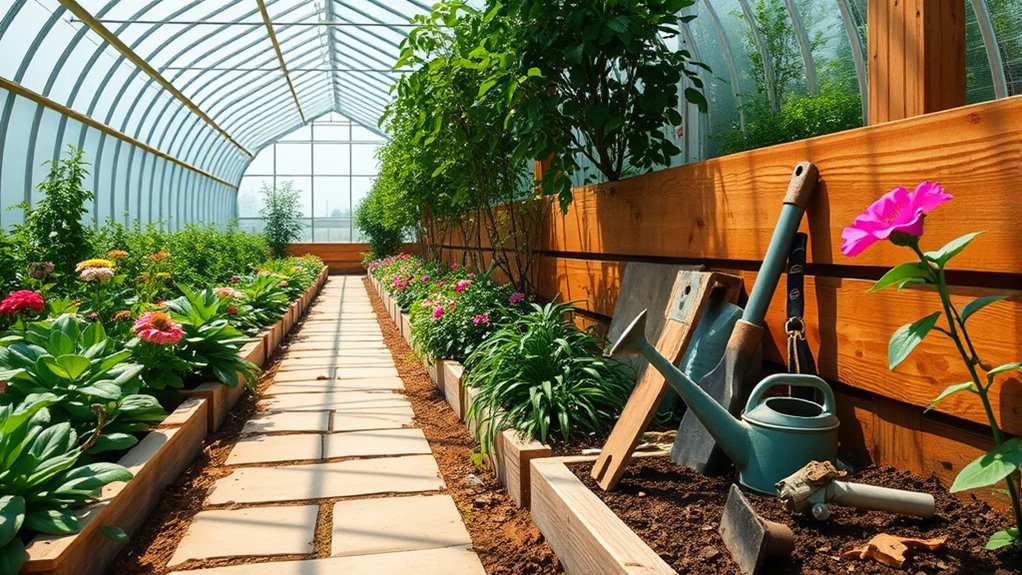
While maintaining pathways in your greenhouse may seem intimidating, a few simple strategies can help guarantee they remain durable and functional for years to come.
Regular upkeep will save you time and money in the long run. Here are some essential maintenance tips:
- Clean Regularly: Sweep away debris to prevent disease and keep pathways safe.
- Inspect for Damage: Check for wear and tear frequently, and address any issues immediately.
- Weed Control: Stay on top of weed growth, as they can compromise pathway integrity.
- Drainage Checks: Verify your pathways drain well to avoid water accumulation, which can damage materials.
Environmental Factors in Pathway Design
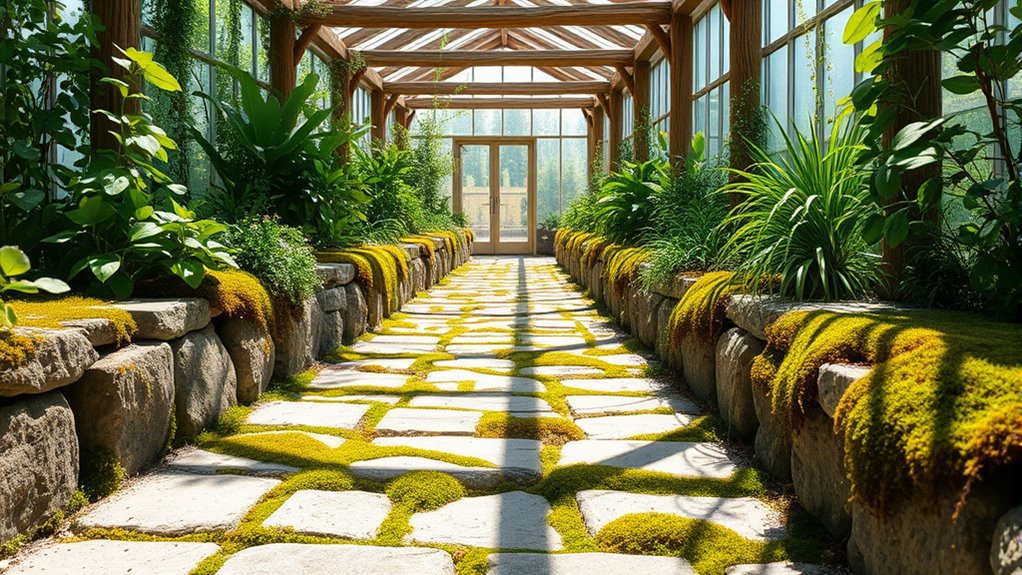
When designing pathways in your greenhouse, considering environmental factors can greatly influence both functionality and plant health.
Ideal temperatures for plant growth range from 15°C to 25°C, so maintaining consistent warmth is essential. Insulation can help regulate interior temperatures, while heating systems become critical in colder climates, especially when leveraging energy-efficient systems for optimal performance.
Your greenhouse should face south or southeast to maximize sunlight, important for photosynthesis.
Be mindful of nearby structures that may cast shade, affecting temperature regulation. Wind direction also plays a role; reinforced framing is necessary in high-wind areas.
Finally, confirm proper drainage systems are in place to manage precipitation and humidity, preventing water accumulation that could harm your plants. Additionally, using sustainably sourced wood for greenhouse structures can enhance insulation and contribute to a more eco-friendly environment.
Budgeting for Your Greenhouse Pathway
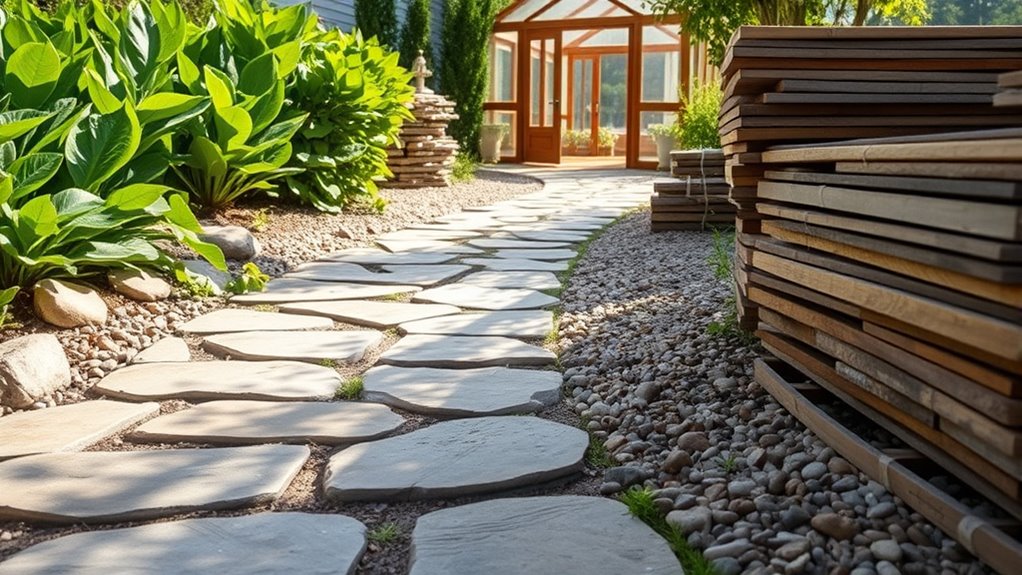
Budgeting for your greenhouse pathway involves careful planning and consideration of various costs to guarantee a successful growing environment. To stay on track financially, keep these key elements in mind:
- Initial Investment: Allocate funds for the greenhouse structure, climate control, and irrigation systems. Costs can range considerably based on size and quality.
- Material Choices: Decide between high-quality materials for durability or more affordable options to save upfront.
- Ongoing Expenses: Factor in utilities, maintenance, and labor costs, which can add up over time.
- Cost-Effective Strategies: Explore DIY options, local partnerships, and financing to help manage expenses while achieving your greenhouse goals.
Ensuring Safety and Accessibility in Pathways
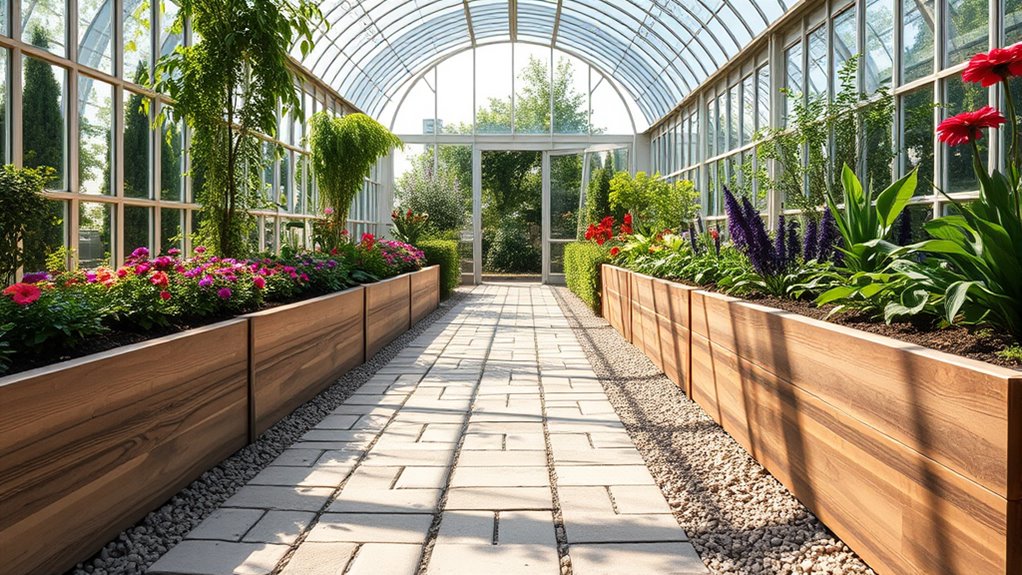
Creating safe and accessible pathways in your greenhouse is essential for guaranteeing that everyone can enjoy and navigate the space comfortably. Aim for pathways at least 48 inches wide, ideally 4 to 5 feet, to accommodate wheelchairs and equipment. Incorporating camping gear reviews can provide insights into durable materials that can withstand the wear and tear of foot traffic. Additionally, using materials with strong suction capabilities can help to keep the pathways clean and free of debris. Regular maintenance that includes preventing buildup of dirt and grime can further enhance the safety and appearance of the pathways. Understanding safety considerations when designing your pathways can also contribute to a more enjoyable greenhouse experience.
Keep paths free from obstacles, and incorporate turning circles where possible. For materials, consider gravel, paving slabs, or natural stone for aesthetics and durability, avoiding sand due to its slippery nature.
Ensure pathways are obstacle-free and include turning circles; opt for gravel or paving slabs for a safe and attractive surface.
Ascertain proper drainage and a non-slip surface for safety, filling any holes or cracks. When dealing with elevation changes, use ramps with a gentle incline and non-slip surfaces.
Add clear signage at eye level to guide users, enhancing overall navigability and accessibility. Additionally, portable camping toilets can be included nearby to ensure hygiene and convenience for all users.
Frequently Asked Questions
What Are the Best Colors for Greenhouse Pathway Materials?
When choosing colors for your greenhouse pathway materials, consider earthy tones like browns and greens that blend seamlessly with your garden.
Neutral shades like gray and beige can provide a subtle backdrop, allowing plants to shine.
If you want to create visual interest, contrasting colors can highlight the pathway.
Just remember, lighter colors reflect sunlight and keep the area cooler, while darker shades absorb heat, impacting your greenhouse environment.
How Do I Prevent Ice Formation on Pathways During Winter?
To prevent ice formation on your pathways during winter, consider a few effective strategies.
Use heated mats or thermal concrete to maintain warmth. Design your pathways with a slight slope for drainage, and keep them clear of snow and debris.
Incorporate insulated materials and consider using permeable pavers to reduce moisture.
Installing a snow melt system can also be beneficial, ensuring your pathways stay safe and accessible throughout the winter months.
Can I Use Recycled Materials for My Pathway?
Yes, you can definitely use recycled materials for your pathway!
Recycled wood, brick, and even crushed glass are great options that not only save money but also help the environment. They provide durability and can add a unique aesthetic to your space.
Plus, using these materials reduces waste and lowers your carbon footprint. Just make sure you consider drainage and maintenance to keep your pathway functional and visually appealing over time.
What Width Should My Greenhouse Pathway Be?
Your greenhouse pathway width should ideally be between 18 to 24 inches for easy movement.
If you need more space for wheelchairs or barrows, consider widening it to 2 to 3 feet.
It’s essential to balance accessibility with space efficiency; narrower paths minimize wasted space in smaller areas.
Additionally, think about your height and reach when customizing the width to guarantee comfort while tending to your plants.
How Do I Integrate Pathways With Existing Plants?
To integrate pathways with your existing plants, position them strategically to allow easy access without disturbing soil or roots.
Confirm pathways are wide enough for maintenance, minimizing compaction. Keep plants spaced well to maintain air circulation and light exposure.
You can also use cover crops alongside pathways to enhance soil health.
Regularly check for any signs of soil disturbance and adjust plant placements as needed to keep everything thriving.
Conclusion
So, whether you’re paving your greenhouse pathway with fancy bricks or just some good ol’ gravel, remember: it’s not just about looking pretty; it’s about avoiding the dreaded mudslide when you’re mid-planting. With a budget that won’t send you into a financial crisis, and a design that screams “I know what I’m doing,” you’ll have the envy of every neighbor. Now, go forth and conquer those pathways—your plants are counting on you, and so is your dignity!
